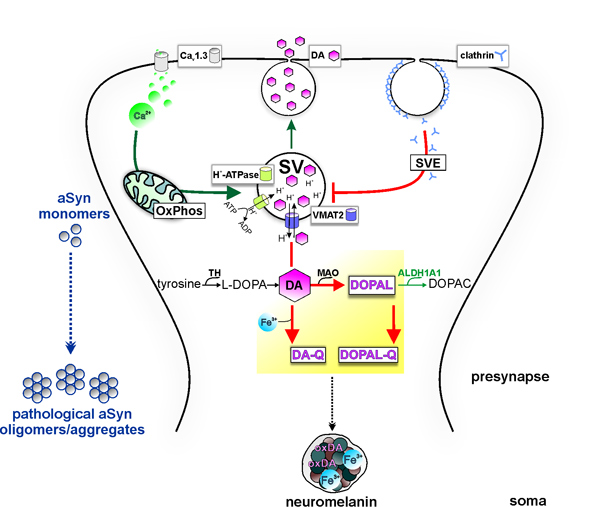Content
Burbulla Lab
My lab is interested in defining key molecular pathways in the pathogenesis of neurodegeneration with a goal of identifying specific targets for therapeutic intervention. In particular, we focus on the second most common neurodegenerative disorder Parkinson’s disease (PD) and more rare neurological disorders such as those in the “Neurodegeneration with Brain Iron Accumulation” (NBIA) family.
In PD, and some subtypes of NBIA, the most susceptible cells are the dopaminergic neurons in the substantia nigra, a structure located in the midbrain. However, the mechanisms underlying their preferential demise are still under investigation. Mitochondrial malfunctions and oxidative stress are considered some of the major causes of neurodegenerative processes. In addition, abnormal metabolism of the neurotransmitter dopamine (DA) is suggested to play a critical role in pathology through excess generation of toxic species (e.g. DA quinones, DOPAL) and oxidative stress.

Figure: Model of the intersection of Parkinson’s disease vulnerability pathways with dopamine metabolism at the presynapse (Minakaki, Krainc & Burbulla, Front. Cell Dev. Biol., 2020)
We utilize induced pluripotent stem cell (iPSC) technology to establish human disease models of relevant central nervous system cell types such as vulnerable dopaminergic neurons and glia from patient’s somatic cells. One major focus of my group is the evaluation of disease progression and identification of key pathogenic mechanisms in long-term cultures of vulnerable midbrain dopaminergic neurons. Combining genomic approaches with functional physiological assays, we focus on the imbalance of DA metabolism and emergence of toxic DA by-products through mitochondrial dysfunction, altered enzymatic DA degradation, and iron dyshomeostasis in patient-derived neurons. As preferential vulnerability of midbrain dopaminergic neurons in PD and subtypes of NBIA may not only arise from cell autonomous mechanisms, my lab also explores neuron-glia crosstalk to investigate the contribution of non-cell autonomous factors contributing to neurodegeneration.
Through our work, we hope to improve understanding of disease progression and identification of relevant targets for therapeutic intervention to benefit a large cohort of patients affected by neurodegenerative diseases.
Responsible for content: Prof. Dr. Lena Burbulla

